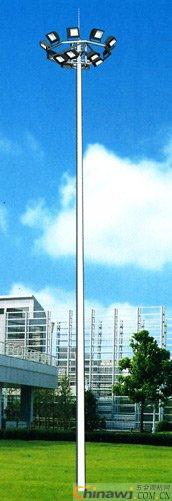The use of high pole lights has gained significant attention and popularity among many companies. However, there are several challenges in their structural design, lighting creativity, and overall aesthetics that have caused confusion for both users and decision-makers during selection. This article explores five key issues related to the structure and design of high pole lights and proposes practical solutions to address them.
One of the main problems with current "naked" street lamps is the material surface treatment, particularly concerning power supply components. These lamps are often directly exposed to the radiator, which may seem beneficial for heat dissipation, but it makes them vulnerable to environmental damage. In reality, most of these lamps are installed outdoors, where they face harsh conditions such as acid rain, sandstorms, and snowfall. Over time, this exposure can significantly reduce their lifespan and performance.
Another issue is the use of aluminum alloy for heat sinks. Although aluminum has excellent thermal conductivity, it is chemically reactive and prone to oxidation. Even after anodizing, the protective oxide layer can be damaged during installation or over time, leading to corrosion. In areas with high pollution, acid rain can accumulate in small gaps, causing long-term damage to the lamp body. Additionally, the open design of these lamps makes them prone to collecting dust and snow, which further reduces heat dissipation efficiency and increases the load on the pole.
The rectangular shape of some high pole lights also poses a problem. Their flat surfaces create resistance when wind blows against them, increasing stress on the pole and its mounting structure. While this might not be noticeable under normal conditions, it can become dangerous in extreme weather, especially in coastal areas where typhoons are common. Over time, aging and corrosion can lead to structural failure, such as bending or falling poles.
The heat island effect is another concern. When high pole lamps rely solely on natural convection for cooling, large radiators can trap hot air in the center, reducing overall efficiency. This results in localized temperature rises, which not only affect performance but also increase the risk of overheating and failure.
The monolithic design of some high pole lights also presents maintenance challenges. These designs make it difficult to replace individual components, forcing users to replace the entire unit. This approach is costly and inefficient, pushing manufacturers to shift from just producing to also offering repair services, which is not sustainable in the long run.
Sharp edges on the heat sink can pose safety risks. They are hard to protect during handling, difficult to coat properly, and can cause injuries to workers. Some manufacturers overlook these details, leading to potential hazards during installation or maintenance.
To address these issues, the author suggests adding a streamlined upper cover to protect the heat sink while still allowing proper ventilation. A modular design is recommended to improve maintainability, and designers should consider user safety and comfort in their work. Furthermore, integrating cultural elements into the design can enhance the appeal and functionality of the product.
As the market becomes more competitive, especially in China, it's crucial for SMEs to focus on quality, aesthetics, and innovation. By creating durable, attractive, and affordable products, companies can build strong relationships with consumers, businesses, and the government, leading to mutual success.
source:

Black Single Hole Basin Faucet
What does single hole faucet mean?
Unlike a three-hole mounting configuration, a single-hole mounting configuration combines the spout and faucet's handle or handles through the mounting hole. This faucet has two separate inlet tubes, one for hot water and another for cold water. Both fit down through the single-mounting hole.
What is a single-hole bathroom faucet?
Single-hole faucets provide more precise volume and temperature control. ... When you want to use a single-hole faucet on a basin with a three-hole installation layout, use an escutcheon, or a deck plate, to hide the other two holes.
Are black fixtures out of style?
It seems like the trend is proving popular: according to interior design bloggers at Lusso, sales for black faucets increased twelvefold in 2019 compared to chrome-plated fixtures. ... And black fixtures are having more than just a moment - they are here to stay.
Our company have gravity casting machines, CNC machines, grinding flats, high-precision measuring instruments and processing equipments. We also employ a large quantity of technical personnel and management personnel and a very professional sales team which will always respond to your queries immediately. Our products mainly are Basin Faucets, Kitchen Faucets, Shower Faucets and other sanitary ware accessories. Furthermore, we have already passed ISO9001: 2015. "Gain development by quality, Win customer by reputation" is always our aim while coordinated with our clients and has been leading us to the exportation of all over the world.
Black Single Hole Faucet, Single Hole Black Faucet, Matte Black Single Hole Faucet, Black Taps For Bathroom, Black Wall Mounted Bath Taps
Kaiping Jianfa Sanitary Ware Co.,Ltd. , https://www.jfsanitary.com